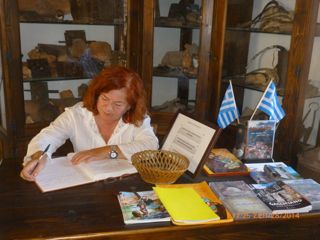Zdravka Mihaylova
For Grreporter exclusive
If Christ had stopped at Eboli, according to the novel by Carlo Levi, where the road and railway line ended and declined to continue into the interior of Lucania (today's Basilicata region), it is certain that He had never reached many other areas of the forgotten-by-progress Italian south, neither the River Amendolea valley in Calabria, where a population, an echo of the past of Magna Grecia (Μεγάλη Ελλάδα) is still living. The writer attributed the title of his novel to the inhabitants themselves, who had told him, "We are not Christians, Christ did not come this far, he stopped at Eboli." In the early 19th century, German researcher Karl Witte discovered the existence of discrete populations in southern Italy, whose mother tongue was Greek. The strong influence exerted by the Greek language on the southern Italian dialects was confirmed a century later by German linguist Rohlfs as well as by many other researchers, mostly Greeks and Italians, who had studied the origin of the dialects spoken in the Greek 'language enclaves' in Apuglia (the Salento peninsula - the heel of the Italian boot) and Calabria (mainly in the mountainous area of Aspromonte on the top of the boot). These studies have proved the existence of a unique language that has preserved words of the ancient Greek Doric dialect that have disappeared from, or are non-existent in, both the Byzantine and modern Greek language.
This confirms the origin and continuity that has existed from the time of Magna Grecia, in particular, from the 8th century BC, when the numerous Greek populations colonized southern Italy and Sicily, to the present day. The Greek colonies Rigion (today Reggio Calabria), Taras (Taranto), Varion (Bari), Vrundision (Brindisi), Epizefirii Locri, Kavlonia, Medma, Croton and Sivaris were established in that era in Calabria. Calabria is a region in Italy that in terms of geography, topography and environment resembles Greece more than any other. Therefore, it is no coincidence that four of the largest Greek colonies in the West were founded along the Ionian seacoast. The largest urban centre in antiquity, Thurii, was designed by famous Ippodamos of Miletus, and famous historian of antiquity Herodotus was buried there. Pythagoras’ contribution to the development of knowledge is remarkable, as was the  school he founded in Croton. The "Tribune of Pythagoras" where the great mathematician preached his theories can be seen in the ruins of the ancient city even today.
school he founded in Croton. The "Tribune of Pythagoras" where the great mathematician preached his theories can be seen in the ruins of the ancient city even today.
Reggio Calabria along with Naples remained the cradle of Hellenism in the western region until the era when it became a province of Byzantine Calabria. Today, its archaeological museum gives shelter to two unique statues, known as "The Warriors of Riace" and the bronze head of "The Philosopher of Porticello". The unique bronze statues of "the warriors" are two of the few examples of Greek art from the Classical era, pulled out from the depths of the sea that, for centuries, was a bridge between, rather than a space separating, Greece and Calabria. It was constantly crossed in both directions by traders, masters of art and their works. The sea monsters Scylla and Charybdis, known from the adventures of Odysseus, the terror of ancient mariners, are actually allegorical mythological images of the dangerous sea currents in the Straits of Messina that separate Sicily from Calabria. It is also the habitat of Fata Morgana, not the fairy from the myth about King Arthur but the physical phenomenon of a reflective image, a mirage, over the Gulf of  Messina, from which stemmed so many legends.
Messina, from which stemmed so many legends.
The origin, history, traditions and contemporary presence of the Greek-speaking population in southern Italy are the topics discussed with ethnologist and social anthropologist Christina Petropoulou.
- You have been involved for many years in a field study of the Greek-speaking areas in Calabria, especially the village of Galiciano, which is the topic of your thesis work defended at the University of Thessaloniki. In the mid-Eighties, when you lived there, the villages along the River Amendolea valley were still inhabited by a Greek-speaking population. There are different theories about its origin and settlement there: the two main ones are that the people were Greek colonists from the 8th century BC, when a large number of them moved to southern Italy and Sicily, and the other one states that they were mostly settlers from the Byzantine era between the 9th and 11th centuries. Who are the "fathers" of these theories and which one do you consider closer to historical truth?